Latest Entertainment News - Indian Entertainment News in Hindi, Hollywood, Bollywood
Get all entertainment news and latest informations in hindi from bollywood and hollywood at patrika.com. It is one of the leading newspapers, 52-year-old and fastest growing multi media conglomerates in rajasthan, India.
Source: www.patrika.com
Rebecca (Fanny) Haralson Gordon
Wife of Confederate General John Brown Gordon
Rebecca (Fanny) Haralson, September 18, 1837, and lived almost into our own time, was the daughter of General Hugh Anderson Haralson of LaGrange, Georgia. Her father had represented Georgia in Congress for many years and was Chairman of the Committee on Military Affairs during the Mexican War.
John Brown Gordon was born in Upson County, Georgia, February 6, 1832, to Zachariah and Malinda Cox Gordon, the fourth of twelve children. His father was a prominent Baptist minister and plantation owner. Around 1840, Zachariah moved his family to Walker County near Lafayette, where he built a summer resort hotel to take advantage of the medicinal appeal of the springs on the property. The hotel subsequently became one of the State's most fashionable vacation spots. Over two decades later, the Battle of Chickamauga was waged in part on the Gordon's property.
Fanny met John Brown Gordon after he left the University of Georgia in 1854 to study law in Atlanta. He was admitted to the Bar later that year, and began a law practice with Basil H. Overby and Logan E. Bleckly. Through them, Gordon met Fanny Haralson, who was the younger sister of the wives of both partners.
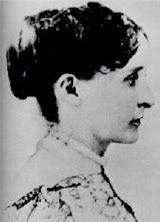
Fanny Haralson Gordon
In love at first sight, 22-year-old John married Fanny on her 17th birthday, September 18, 1854. The wedding took place at Myrtle Hill, the Haralson's ancestral home near La Grange, Georgia. It was a small private affair in her father's bedroom, because his health had taken a bad turn. In fact, one week later her father, General Haralson, died. Shortly after the wedding, John and Fanny moved to Atlanta. Theirs was a long and happy marriage.
When his practice began to falter, Gordon switched to journalism and wrote for a newspaper in Milledgeville – then Georgia's capital – for a year before moving to northwest Georgia to open a coal mining company. It was there, at the juncture of Georgia, Alabama and Tennessee, that Gordon was living when the Civil War erupted in 1861.
By the time war came, the Gordons had two small boys and were operating a coal mining company. Hus¬band and wife struggled with their loyalties to family and country. Gordon wrote in his memoir that Fanny "ended doubt as to what disposition was to be made of her by announcing that she intended to accompany me to the war. She left their children with relatives to free her up for what in her judgment was a higher duty. Because of Southern custom, she couldn't be a battlefield nurse, but she could stay in the camps while the battles in which John fought were raging nearby.
John Brown Gordon was just 28 years old when the war began, yet by the end of the war, he was second in command only to General Robert E. Lee. In 1861, he enlisted as a private soldier, and was elected captain of a volunteer company he recruited, which was composed of men from the mountains, and they became known as the "Raccoon Roughs."
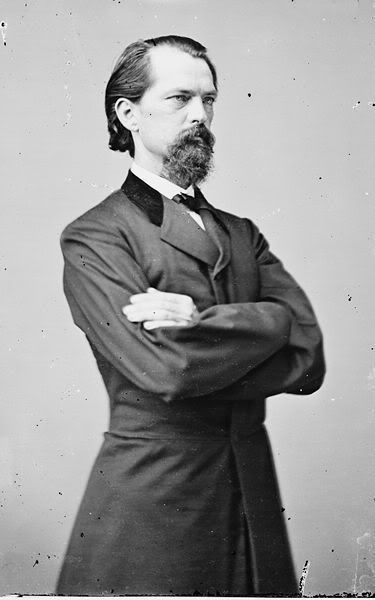
General John Brown Gordon
By Matthew Brady
Fanny Gordon accompanied her general throughout the war, and is credited with saving his life when he was wounded five times at Antietam. Assigned by General Lee to hold an essential position during the Battle of Sharpsburg, Gordon's men were tremendously outnumbered. Their only hope, he decided, was for his men to hold their fire until the enemy troops were practically on top of them and then all fire at once. Their first volley knocked down almost the entire Yankee front line. Subsequent lines of Yankees met a similar fate.
But many Confederates also fell at what would be called the Battle of Bloody Lane (a sunken road), including Gordon. First, a minie ball passed through his calf, a second ball hit him higher in the same leg, a third through his left arm, mangling the muscles and tendons in his arm were mangled and severing a small artery. A forth ball hit him in his shoulder. Despite pleas he go to the rear, Gordon continued to lead his men.
General Gordon was finally stopped by a ball that hit him in the face, passing through his left cheek and out his jaw, leaving him helpless and insensible on the field. He fell with his face in his cap and might have drowned in his own blood if there hadn't been a bullet hole in the cap.
Gordon was carried on a litter to a barn where 6th Alabama Assistant Surgeon Thaddeus J. Weatherly dressed his wounds. When Gordon revived late that night he found himself lying on a pile of straw. His spirited young wife Fanny came to the barn as soon as she learned her husband had been wounded. When she reached him, she suppressed a scream as Gordon struggled to joke with her, saying he had been to an Irish wedding.
Fanny nursed her husband for seven months. She dressed his wounds, fed him brandy and beef tea because his jaw was wired shut, and provided long hours of bedside care and devotion. "Thenceforward, for the period in which my life hung in the balance, " the general wrote, "she sat at my bedside, trying to supply concentrated nourishment to sustain me against the constant drainage."
The facial wound caused his face to blacken and swell and his eyes to narrow, so much so that he could barely see. None of this deterred her. His jaw had been wired shut, which made feeding an extremely difficult proposition, but she knelt at his side and managed to get a little liquid nourishment past his clenched teeth.
When erysipelas, a serious bacterial infection, attacked his left arm, she painted it relentlessly with iodine. "Under God's providence, I owe my life to her incessant watchfulness night and day, and to her tender nursing through weary weeks and anxious months, " Gordon recalled. With Fanny's care and his own strong will, Gordon miraculously recovered.
Gordon returned to duty in March 1863 and was given command of a brigade of six Georgia regiments in Lt. General Jubal Early's Division. After leading a successful assault on Marye's Heights in Fredericksburg during the Battle of Chancellorsville in May, Gordon was promoted to brigadier general.
After General Robert E. Lee restructured his army, Early's Division was absorbed into Lt. General Richard Ewell's Second Corps and marched into the Shenandoah Valley as part of Lee's second attempt to invade the North. At Gettysburg on July 1, 1863, Gordon's brigade of 1200 Georgians rolled up the Federal right flank north of the town and was driving the Yankees until ordered to halt by Early and Ewell, which Gordon later contended was a mistake that cost the Rebels the battle.
Gordon was a brilliant and captivating orator – a skill he put to effective use during the War to inspire his men. A Confederate officer at Gettysburg recalled that the sight of Gordon mounted on his magnificent, coal-black stallion as being "the most glorious and inspiring thing" he had ever seen. It was, he declared, an unforgettable "splendid picture of gallantry." Gordon "standing in his stirrups, bare headed, hat in hand, arms extended and, in a voice like a trumpet, exhorting his men" was "absolutely thrilling."
Fanny mostly kept pace, going to the rear before battles. Her husband marveled at her courage. "It requires the direst dangers, especially where those dangers threaten some cause or object around which their affections are entwined, to call out the marvelous courage of women, " Gordon wrote. "Under such conditions they will brave death itself without a quiver."
In the Overland Campaign, Gordon commanded a division in Ewell's (later Early's) corps at the Battle of the Wilderness near the grounds of the Chancellorsville battlefield. His God-given ability to inspire his troops almost to madness was notably done on May 12, 1864, at the Battle of Spotsylvania Court House.
General Lee was prepared to lead the charge of Gordon's men when Gordon rode up and said: "General Lee, this is no place for you. These men behind you are Georgians and Virginians. They have never failed you and will not fail you here." Then they took up the chant, "Lee to the rear, " and Gordon seized Lee's horse's bridle and ordered some men to take Lee to the rear.
Gordon's success in turning back the massive Union assault at the Bloody Angle prevented a Confederate rout, and his erect posture saved his life, as a ball went through the back of his coat, just missing his spine. Some believe that Gordon's success in turning back the Federals at the Bloody Angle gave the Confederacy an additional year of life.
After Cold Harbor, Gordon left with General Jubal Early for the Valley Campaigns of 1864. Unbeknownst to John, Fanny followed him on June 14, 1864. At one point, her carriage broke down and she was almost captured, but with the help of men from the command of Robert Rodes, she continued unmolested.
On September 19, 1864, Fanny rushed out into the street during the Third Battle of Winchester to urge Gordon's retreating troops to go back and face the enemy. With bullets flying all around her, she shouted, "Go back to the front lines, you cowards! Turn around and fight." Fortunately, no harm came to either of them.
Gordon was horrified to find her in the street with shells and balls flying about her. "I saw Mrs. Gordon on the streets of Winchester, under fire, her soul aflame with patriotic ardor, appealing to retreating Confederates to halt and form a new line to resist the Union advance. She was so transported by her patriotic passion that she took no notice of the whizzing shot and shell, and seemed wholly unconscious of her great peril."
Lt. General Jubal Early, a bachelor, had little patience with wives who tried to follow their officer husbands to war. He remarked that he wished the Yankees would capture Mrs. Gordon because she always seemed to be around. Yet when she teased him about the remark during a dinner, Early relented, saying, "Mrs. Gordon, General Gordon is a better soldier when you are close by him than when you are away, and so hereafter, when I issue orders that officers’ wives must go to the rear, you may know that you are excepted."
In December 1864, Gordon was ordered to rejoin the Army of Northern Virginia as commander of the bulk of the Second Corps while Early remained in the Valley. Lee's army faced a siege at Petersburg, Virginia, by Lt. General Ulysses S. Grant and the Army of the Potomac.
Fanny Gordon stayed as near to the general as possible until late in the war – when she was incapacitated by childbirth, and ended up behind enemy lines in Virginia.
General Gordon's career was perhaps as brilliant as that of any officer in the Confederate army. In rapid succession he filled every grade – that of Major, Lieutenant Colonel, Colonel, Brigadier General, Major General, and, near the end, was assigned to duty as Lieutenant General (by authority of the Secretary of War).
For General John Brown Gordon, April 9, 1865, began with leading his weakened and hungry forces into battle at Appomattox Court House, Virginia. When Lee's army had "been fought to a frazzle" and was surrounded by the enemy, General Gordon led the last charge of the Army of Northern Virginia, and captured the entrenchments and several pieces of artillery in his front.
Hours later, the Civil War was over. Gordon commanded, at the surrender at Appomattox, one half of the Army of Northern Virginia, under Robert E. Lee. On April 12, 1865, Gordon's Confederate troops officially surrendered to Major General Joshua L. Chamberlain, who was acting for General Ulysses S. Grant.
After the war ended, because fighting in North Georgia had damaged the Gordon's coal mines, and they lacked the money needed to reopen them, General Gordon had to look for a new occupation. After briefly owning and managing some sawmills near Brunswick, he moved to Kirkwood, an Atlanta suburb, and went into the insurance and publishing businesses.
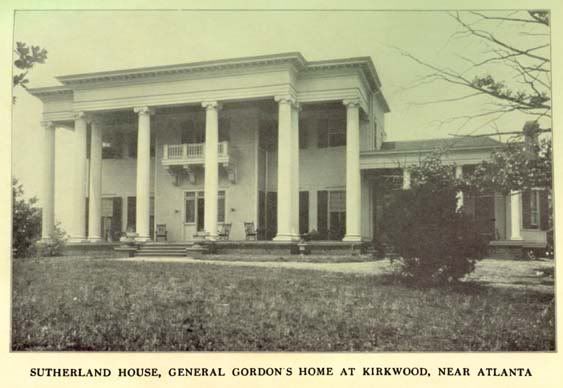
Gordon rose through the ranks in civilian life as he had during the war. It must be said that after the war, he was a strong opponent of Reconstruction, and was generally acknowledged to be the titular leader of the Ku Klux Klan in Georgia during the late 1860s – another Southern military figure, fighting to preserve a way of life that had already been lost.
Gordon lost his first run for governor in 1868, but the state Legislature selected him to represent Georgia in the US Senate, where he served from 1873 to 1880. In the Senate, he concentrated on economic issues and fostering national reconciliation. He was hailed by the New York Times as "the ablest man from the South in either House of Congress."
Gordon's career was tainted by scandal in 1880 when, having been reelected to the US Senate, he suddenly resigned to become general counsel of the state-controlled Western and Atlantic Railroad. When Governor Alfred Colquitt promptly appointed the railroad's former president Joseph E. Brown to fill Gordon's unexpired term as senator, a cry went up within his own Democratic Party that a corrupt bargain had been struck.
Although Gordon claimed that he was acting in the best interest of the party and his constituency by retiring from public life, he was never able to fully counter the charges by his critics that he was motivated strictly by personal gain.
None of this, however, detracted from his popularity. In 1886, he was elected governor of Georgia, and he stayed in the position until 1890, then rejoined the US Senate for another six years. When the United Confederate Veterans was organized in 1889, he was made the group's president.
As aggressive and optimistic in business as he had been in war, Gordon invested in a wide variety of businesses and a white elephant plantation in Taylor County. He lost most of his money in a failed venture to build a railroad from Georgia to Key West and establish a steamship line to linking it to Latin America.
Mistakes made by the Memphis branch of the insurance company, whose Atlanta branch Gordon headed, caused the company to go bankrupt. Gordon's financial status remained precarious for the rest of life and gave substance to claims that he exchanged political favors for money.
During the last decade of his life, " says Ralph Lowell Eckert (author of John Brown Gordon: Soldier, Southerner, American) "Gordon remained extremely active in his efforts to vindicate the South and at the same time to establish a new spirit of nationalism" by embarking on a career as a lecturer. He retired from politics in 1896. For several years he lectured, and he published his highly successful memoir, Reminiscences of the Civil War, in 1903.
With Fanny at his side, John Brown Gordon died in Miami at age 71 on January 9, 1904, three months after his memoir, Reminiscences of the Civil War, was published. Despite his extremely debilitated state, he managed a last look, a smile and a touch for the one who had loved him and been loved by him almost from the day their eyes met, who had been with him in body and in spirit for half a century and who had been all things to him.
The general even received a tribute from President Theodore Roosevelt, who summed up what many felt by saying, "A more gallant, generous, and fearless gentleman and soldier has not been seen by our country."
Fanny soldiered on without him for another 27 years, but her life was a pale copy of the life she knew with the knight known as John Brown Gordon, who, it was said, was the only Civil War commander who was never defeated or repulsed when he led a charge or when he was in command.
Rebecca (Fanny) Haralson Gordon died April 28, 1931, at the age of 93 – an almost unheard of longevity in those days.
SOURCES
John Brown Gordon
Shot by Cupid’s Bow
John B. Gordon (1832-1904)
General John Brown Gordon
John and Fanny - A Love Story
Wikipedia: John Brown Gordon
The 9 Lives of General John Brown Gordon
Source: feedproxy.google.com
Cremora (Belle) Cave Kemper
Wife of Confederate General James Lawson Kemper
Cremora Cave was born in 1834, the daughter of Cremora and Belfield Cave. James Lawson Kemper was born on June 11, 1823, to William and Maria Allison Kemper in Madison County, Virginia. He was the sixth of eight children, and his childhood was spent at the two-story family home called Mountain Prospect, which also included 600 acres of land. His immediate family as well as four of his father's sisters, his maternal grandmother, and several domestic servants also lived there.
The first education that James Lawson Kemper received was in a field school built near his home. The Hill and Kemper families hired a teacher to teach their children in this building. One of Kemper's grade school friends, who became a friend for life, was Ambrose Powell Hill, better known as General A.P. Hill.
James was accepted to Locust Dale Academy when he was 13 years old, where he stayed from 1830-1840. He enrolled at Washington College (now Washington and Lee University), and received a Bachelor of Arts and graduated first in his class in the spring of 1842, and received a Master's Degree in 1845.
After graduating from Washington College , Kemper decided to study law. Under the supervision of Judge George W. Summers of Charleston, Kanawha County, Virginia, he read the law and then successfully took the bar exam, and began practicing law a year later. At the outbreak of the Mexican War in 1846 Kemper was commissioned a captain in the Virginia volunteers, but did not see active service.
Returning to Virginia and his law practice, in 1853 Kemper was elected to the Virginia House of Delegates for the first of five terms, the last (1861-1863) as Speaker of the House. Early letters (pre-1861) illustrate Kemper's growing law practice and his involvement in politics.
In 1850, at about the age of twenty-seven, James began to court Cremora Conway Cave, affectionately called Belle by her future husband. She was sixteen years old at the time. Despite the age difference, on July 4, 1853, they were married by Reverend J. Earnest at the Madison Court House, and they were to have seven children.
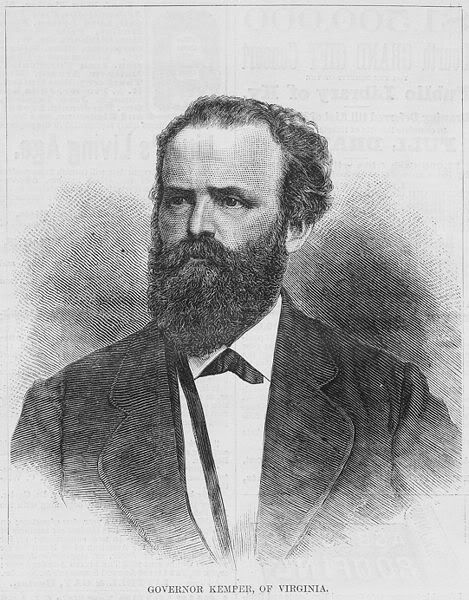
General James Lawson Kemper
Harper's Weekly, January 17, 1874
At the beginning of the Civil War, James Kemper was a member of the Virginia State Legislature and helped organize Virginia troops for the Confederate forces. Rising through the ranks, he fought at Bull Run, South Mountain, Antietam, Fredericksburg, and was promoted Brigadier General in June, 1862. He was the youngest of the brigade commanders, and the only nonprofessional military officer in the division that led Pickett's Charge, in which he was wounded and captured.
After a gallant performance at the Battle of Seven Pines during the Peninsula Campaign, Kemper was promoted to brigadier general on June 3, 1862, and briefly commanded a division in Longstreet's Corps. Upon the return to duty of wounded Major General George Pickett, Kemper reverted to brigade command.
In 1863, Kemper's brigade was assigned to Pickett's division in Longstreet's Corps, and missed the Battle of Chancellorsville while the corps was assigned to Suffolk, Virginia. But the corps returned in time for the Gettysburg Campaign, and Kemper rejoined Lee's army as a brigade commander in Pickett's division.
At Gettysburg, Kemper arrived with Pickett's division late on the second day of battle, July 2, 1863. His brigade was one of the main assault units in Pickett's Charge on July 3, 1863, advancing on the right flank of Pickett's line. After crossing the Emmitsburg Road, Kemper's brigade was hit by flanking fire from two Vermont regiments, driving it to the left and disrupting the cohesion of the assault. Kemper rose on his spurs to urge his men forward, shouting "There are the guns, boys, go for them!"
This bravado made him a more visible target, and he was severely wounded by a bullet in the abdomen and thigh and captured by Union forces. Kemper was rescued by Confederate forces and carried back to Confederate lines on Seminary Ridge, but was too critically injured to be transported during the retreat from Gettysburg, and was left behind to be treated and recaptured. Newspaper accounts at the time claimed he was killed in action, and Robert E. Lee sent condolences to his family.
There exists a letter from Major General Ethan A. Hitchock, explaining to Kemper's wife Belle that she could not see her captured and badly wounded husband because Confederate authorities had refused the same courtesies to a Union family.
For three months, Kemper was a prisoner in a Federal hospital, and was exchanged September 19, 1863, on a certificate of the Federal surgeons that he could not live long. A long furlough enabled him to recover sufficiently to don his uniform again. For the rest of the war, he was too ill for combat – the bullet that struck him could not be removed surgically, and he suffered from groin pain for the remainder of his life.
From June 1864 until the Confederate surrender, Kemper was in command of the local forces around Richmond. He was promoted to Major General on September 19, 1864. After Appomattox he was paroled by United States military authorities on May 2, 1865.
After the war ended, General Kemper returned to Madison County to practice law and focus on rebuilding the state. He was concerned about Belle's health. Her condition began to decline – she had not been physically strong before. She came down with an eye infection that deteriorated her sight to the point of blindness within a few years.
Although he was involved with legal matters much of the time, James managed to take time to spend with his family. Depending mostly on income from his legal practices, he managed to make a decent living for himself and his family. Every year, James and Belle would take a vacation to the mineral springs.
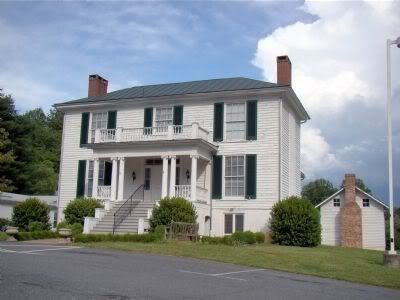
James L. Kemper Residence
The land on which the Kemper Mansion sits was originally a 52 acre parcel on the north end of the Town of Madison, Virginia. Kemper bought the house and lot in 1868, after he came home to discover that his old house had been destroyed in a raid led by General George Armstrong Custer. It was built with an antebellum frame structure that was becoming very popular at the time (circa 1852) - the Greek Revival style. He practiced law in a small log cabin office behind the home after the war.
In 1870, Belle became very ill. Just when they thought she was going to recover, her condition made a turn for the worse. At the time, she was pregnant with their seventh child, and on September 8, she gave birth to their son, Reginald Heber Johns. The birth complicated things even more and within a month, Cremora (Belle) Cave Kemper died at the age of thirty-three. James couldn't stand to live in the house anymore, and spent his nights in his office on the grounds.
James Kemper was elected the first Governor of Virginia after Reconstruction, serving from 1874 to 1878. He became well known for his honesty and integrity, his initiation of the public school system, improvements on the public transportation system, and his strong position on civil rights.
As governor, Kemper fought for full civil rights and protection for the freedmen. He also supported a new constitution and the restoration of Virginia to normal relations with the United States. After he served his last term as governor, Kemper was offered the position as US Senator, but declined, thus ending his political career.
Kemper was worn out physically and emotionally. In 1882, he moved into a new home at Walnut Hills in Orange County, Virginia. Walnut Hills was a mid-sized farm in a secluded area, where he retired to enjoy sheep farming and practicing law. The home overlooked the Rapidan River and had a lovely Blue Ridge view.
At the time, there were six of his seven children still living.
Eventually, James Lawson Kemper's health deteriorated, and he died in his sleep at Walnut Hills on April 7, 1895, and was buried in the family cemetery there.
SOURCES
James L. Kemper
Marriage and Family
James Lawson Kemper
Early Life and Education
A Guide to the Papers of James Lawson Kemper
Source: feedproxy.google.com
Latest World News - Business, Sports, Entertainment, Politics, Education, International, Hindi
Patrika.com is fastest growing hindi news portal covering all national and international news from the category of business, sports, entertainment, politics, education and lots more with wide network of corporate offices across major cities of India.
Source: www.patrika.com
Charlotte Maria Cross Wigfall
Wife of Confederate General and Senator
Charlotte Maria Cross was born in 1818, and there is no further information about her early years. Louis Trezevant Wigfall was born April 21, 1816, on a plantation near Edgefield, South Carolina, to Levi Durant and Eliza Thomson Wigfall, a well-to-do socially-prominent couple. His father, who died in 1818, was a successful Charleston merchant before moving to Edgefield.
His mother was of the French Huguenot Trezavant family, and died when young Louis was 13. He was reared in a privileged and extremely class-conscious society. He immersed himself in the agrarian culture of the region and devoted himself to preserving and expanding it.
Tutored by a guardian until 1834, Louis then spent a year at Rice Creek Springs School, a military academy near Columbia, South Carolina, for children of elite aristocrats. He attended the law department of the University of Virginia at Charlottesville. A perceived insult by another student prompted the first of many dueling challenges he would make.
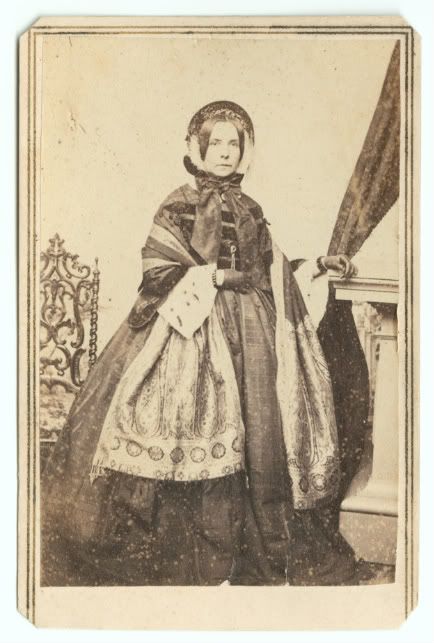
Charlotte Maria Cross Wigfall
In 1836, he entered South Carolina College to complete his studies, and graduated in 1837. Most of his time was spent at off-campus taverns rather than at his studies. During this time, he abandoned academics altogether for three months to fight in the Seminole War in Florida, achieving the rank of Lieutenant of volunteers.
In 1839, Wigfall was admitted to the bar, and returned to Edgefield and took over his brother's law practice. Having squandered his inheritance, and with a proclivity for drinking and gambling, he accumulated debts. He borrowed from friends to maintain a freewheeling lifestyle, including from his second cousin and future bride, Charlotte Maria Cross of Rhode Island, whom he married in 1841.
Business as an upcountry lawyer didn't suit his temperament and sense of purpose, nor prove to be as profitable as he had hoped. Wigfall believed in a society led by the planter class and based on slavery and the chivalric code. He often neglected his law practice for contentious politics.
In a five-month period in 1840, Wigfall managed to get into a fistfight and two duels, three near-duels, and was charged, but not indicted, for killing a man. This orgy of violence culminated in 1840 on an island in the Savannah River, where he took a bullet through both thighs while dueling with future Congressman Preston Brooks. His reputation as a duelist, often exaggerated, followed him his entire life, though he gave up the practice entirely after his marriage.
His initial foray into politics and the Brooks affair destroyed his law practice. He was elected delegate to the South Carolina Democratic Convention in 1844, but his violent temperament and behind-the-scenes meddling had already doomed his youthful political ambitions. He piled up medical bills on a sickly infant son who eventually died. Sheriff sales followed, swallowing up his Edgefield estate.
Wigfall witnessed South Carolina's dispute with the federal government over tariffs and became a lifelong advocate of states' rights. He carried his two core beliefs - in the romance of the Old South and the sovereignty of individual states - with him to Texas in 1848.
After Texas joined the United States in 1846, tens of thousands of immigrants poured across its borders in search of cheap land and new lives. Most came from the American South, which by then had developed a distinct culture based upon cotton and slavery.
A Texas cousin, James Hamilton, Jr., a former governor of South Carolina, arranged a fresh start for Wigfall, and a law partnership. First arriving in Galveston in 1848, he then moved with his wife, Charlotte, and their three children to Nacogdoches, where he was a law partner of Thomas J. Jennings and William B. Ochiltree. Soon Wigfall opened his own law office in Marshall.
Wigfall was active in Texas politics from the moment he arrived, alerting Texans to the dangers of abolition and the growing influence of non-slave states in the United States Congress. He quickly established himself as one of the community's most ardent and vocal fire-eaters, a name given to Southerners who supported radical means to defend slavery and states' rights.
At the Galveston County Democratic convention in 1848, Wigfall condemned congressional efforts to prohibit the expansion of slavery into the territories, and expressed sorrow that Texas would not take the lead in opposing such unconstitutional actions.
Wigfall served in the Texas House of Representatives from 1849–1850, and in the Texas Senate from 1857–1860. He played a major role in organizing Texas Democrats and fighting the American (Know-Nothing) party in 1855-56.
When Senator Sam Houston ran for governor in 1857, Wigfall followed him on the campaign trail, attacking his congressional record at each of Houston's stops, and accusing Houston of being a coward and a traitor to Texas and the South. Wigfall claimed that Houston had ambitions for a presidential nomination and courted the support of Northern abolitionists. Wigfall was one of the few men in Houston's opposition who rivaled him as a stump speaker, and he was widely credited with Houston's defeat for the governorship in 1857.
In 1858, Wigfall had a strong voice in the state Democratic convention that adopted a states' rights platform. With the breakup of the Know Nothing Party, many moderates moved back into the Democratic party, and it appeared that Wigfall's radicalism was repudiated. But he capitalized on the fear that John Brown's raid on Harper's Ferry caused in the slave states.
In 1859, Wigfall was selected by the legislature to represent Texas in the United States Senate, filling the vacancy caused by the death of J. Pinckney Henderson and served from December 5, 1859, until March 23, 1861. As "the most violent partisan in the state, " according to one contemporary, Wigfall was a natural choice for a state that was more and more supportive of the political position of the Deep South.
In the Senate, he became a leader in the effort to assure southern slave-owner's freedom to settle in the territories with their slaves. He continued his by-now familiar diatribes against federal powers and northern intrusion into southern life. He rarely concerned himself with Texas, but identified closely with his native South Carolina.
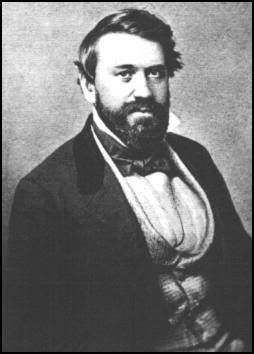
Louis Trezevant Wigfall
Wigfall was among a group of leading secessionists known as Fire Eaters. He earned a reputation for eloquence, acerbic debate, and readiness for encounter. He continued his fight for slavery and states' rights and against expanding the power of national government. His reputation for oratory and hard-drinking, along with a combative nature and high-minded sense of personal honor, made him one of the more imposing political figures of his time.
One of the most vociferous advocates for secession, and one of the people most responsible for tying the fortunes of the Lone Star State to the Confederacy, was Louis T. Wigfall. Texas had become a part of the Old South, and when southern states began leaving the Union in 1860, Texas followed suit. In 1860, Wigfall was instrumental in fracturing the Democratic Party, hoping to kill any possibility of compromise between north and south.
Insisting that the Democratic party platform of 1860 call for the Federal government to guarantee protection of slavery in the territories, he was key to the split of the Democratic party and the subsequent election of Abraham Lincoln as president.
Wigfall coauthored the Southern Manifesto, declaring that any hope for relief in the Union was gone, and that the honor and independence of the South required the organization of a Southern Confederacy. Wigfall helped foil efforts for compromise to save the Union and urged all slave states to secede. When South Carolina led the parade of southern states out of the Union, Wigfall rejoiced.
Wigfall joined the Texas delegation to the Montgomery Conference in Alabama, which formed the provisional government of the Confederacy, and which selected Jefferson Davis as its president. In Washington, Wigfall continued to hold his seat for 6 days after Texas had seceded on March 1, 1861, exhorting the rightness of the Southern cause and berating his Northern colleagues on the floor of the Senate and in Capitol Hill saloons.
During this time in Washington, he spied on Federal preparations for the coming conflict, secured weapons for delivery south, and went to Baltimore, Maryland, and recruited soldiers for the new Confederacy before traveling to the Confederate capital at Richmond, Virginia. He was one of ten Southern senators who were expelled in absentia on July 11, 1861.
He was admitted to the Provisional Confederate Congress on April 29, 1861, where he served on the Committee on Foreign Affairs. Wigfall was at Fort Sumter in April 1861 when the Civil War began, gleefully demanding the surrender of the Federal post. Between April and July 1861, he was a member of the Provisional Congress of the Confederacy, and served as an aide to Confederate President Jefferson Davis.
Wigfall continued his service to the Confederacy as a military commander - without great distinction, as according to many accounts he was often inebriated. He was commissioned colonel of the First Texas Infantry on August 28, 1861, and on November 21 Davis nominated him brigadier general in the Provisional Army, a move later confirmed by the Confederate Congress.
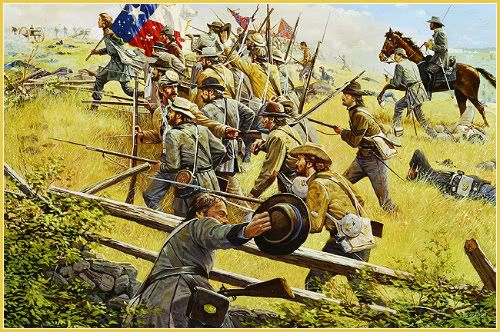
Mrs. Wigfall's Wedding Dress
Charlotte Maria Cross Wigfall, wife of the 1st Texas Regiment's Colonel, made her wedding dress into a Lone Star Flag for the Regiment, and presented this flag that she had sewn by hand to the regiment in the summer of 1861. Carried by the 1st Texas Infantry of General John Bell Hood's Brigade, the flag was captured during the Battle of Sharpsburg – September 17, 1862 – after nine of the men who carried it had fallen.
Artist: Dale Gallon
Wigfall commanded the Texas Brigade of the Army of Northern Virginia (Hood's Texas Brigade) until February 20, 1862, when he resigned to take a seat in the Confederate Senate and represented the State of Texas for the remainder of the war. Despite his public advocacy of states' rights, Wigfall did little for Texas. In the Senate, he worked for military strength at the expense of state and individual rights.
An arrogant man, Wigfall came into conflict with President Davis. After the chief executive vetoed Wigfall's bill to upgrade staff positions in the army and limit presidential selection, Wigfall carried his fight into social circles, even going so far as to refuse to stand when Davis entered the room. Although a friend and supporter of the Confederate military, he was also an obstructionist in opposing Davis' nominations.
When Richmond fell, Wigfall fled Virginia. He first went home to Texas for almost a year. In the spring of 1866, he moved to England, and spent six years in self-imposed exile. He practiced law in England, but returned to the United States in 1872, first residing in Baltimore, MD.
Louis Trezevant Wigfall returned to Texas, landing at Galveston in January 1874. He intended to revive his long-dormant law practice, but he died unexpectedly on February 18, 1874, and was buried at Trinity Episcopal Church Cemetery in Galveston. I found no record of the death of Charlotte Maria Cross Wigfall.
SOURCES
Louis Wigfall
The Fire Eaters
Louis T. Wigfall
Louis Trezevant Wigfall
The Handbook of Texas Online
Confederate Gazette – PDF FILE
Ordinance of Secession of Texas
Politicians in Trouble or Disgrace: Texas
Source: feedproxy.google.com
Patrika.com - Share Opinion - Local Chat - Local Poll - Local News Globally
Patrika - A Hindi news portal brings latest news, headlines in hindi from India, world, business, politics, sports and entertainment.
Source: www.patrika.com
Patrika Photogallery - Rajasthan Pictures - Jaipur Photos - News Photos
Patrika - A Hindi news portal brings latest news, headlines in hindi from India, world, business, politics, sports and entertainment.
Source: www.patrika.com
Pakistan Army tightens noose around Bait Mehsud
The patriotic Mehsud leaders Qari Zain and Turkistan Bittani have now brought in two other Musud leaders of South Wazirisitan Mullah Nazir and Hafiz Gul Bahadur. We had previously reported that Turkistan had joined Qari Zain now that alliance has been expanded. Using the latest surveillance techniques the Pakistani Law agencies had monitored and taped the [...]

Source: rupeenews.com
Sallie Robbins Broadhead
Civil War Nurse and Teacher
Sallie Robbins Broadhead, a teacher in Gettysburg, Pennsylvania, lived on the western end of Chambersburg Street in the end unit of a row house called Warren's Block with her husband Joseph and 4-year-old daughter Mary. Sallie, a thin, plain-looking young woman, kept a daily diary from mid-June to mid-July 1863, providing a graphic firsthand account of the ordeal endured that summer by the civilians of Gettysburg.
Gettysburg's residents, about 2400 in number, knew that Southern troops were not very far away. On June 21, Captain Robert Bell's local cavalry company and members of the Philadelphia City Troop had exchanged shots with Confederate pickets at Monterey, less than 20 miles from Gettysburg. The Adams Sentinel, one of Gettysburg's weekly newspapers, had reported on June 23 that sizable Confederate forces had entered nearby towns to look for supplies and horses.
The wonderful Gettysburg paintings included in this post are available at Dale Gallon's Official Website.
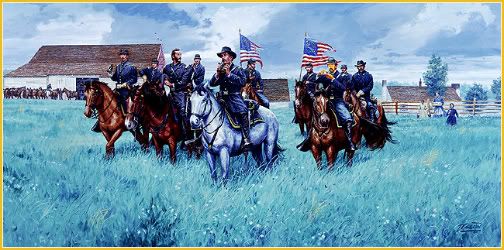
Coming Rain
Brigadier General John Buford at McPherson's Farm June 30, 1863
Buford with his brigade commanders, Devin and Gamble, discuss the impending battle.
By Dale Gallon
On June 23, 1863, Sallie Broadhead wrote in her diary:
As I expected, the Rebels have, several times, been within two or three miles, but they have not yet reached here. Two cavalry companies are here on scouting duty, but they can be of little use, as they have never seen service. Deserters come in every little while, who report the enemy near in large force.
The townspeople had heard false alarms and conflicting stories. On June 24, Sallie Broadhead had tried to convince herself that all would be well. "We are getting used to excitement, and many think the enemy, having been so long in the vicinity – without visiting us, will not favor us with their presence, " she had written in her diary.
The experiences that Sallie would never forget began on the morning of June 26, 1863. She was sound asleep when her daughter Mary cried for water. When Sallie got up, she heard a commotion and looked out the window to see a large fire, and citizens were calling out that the rebels were coming.
General Early's Raid
On that rainy Friday afternoon of June 26, Confederate Major General Jubal A. Early and his division, some 5, 000 men, were marching toward Gettysburg. Seven or eight miles from the small Pennsylvania town, he heard rumors that an enemy force of unknown strength awaited him there. Early approached Gettysburg from the west, and skirmished with 750 green troops in the 26th Pennsylvania Emergency Volunteers.
Early had only planned to stop in Gettysburg long enough to collect supplies for the army. Lt. General Richard S. Ewell, commander of the 2nd Corps during Gen. Robert E. Lee's great invasion of the North, had given Early some other urgent tasks. After hurrying through Gettysburg, he was supposed to cut the Northern Central Railroad, at York, then destroy the imposing Columbia Bridge across the Susquehanna River at Wrightsville. If successful, he would help to pave the way for the capture of Harrisburg, the state capital.
From the top of a ridge about four miles outside Gettysburg, Colonel William W. Jennings, using his field glasses, eventually spotted Early's approaching troops. Attempts to raise 50, 000 militia for Pennsylvania's defense had not met with much success. Jennings' outfit, the 26th Pennsylvania Militia, was one of the groups hastily thrown together to challenge the Southern invaders. Among its 743 members were young men from Pennsylvania College and the Lutheran Theological Seminary, two schools in Gettysburg.
Galloping down Chambersburg Street into town, Early's advance troops put on a performance that disgusted the Reverend Dr. Michael Jacobs, a prominent citizen. "The advance guard of the enemy, consisting of 180 to 200 cavalry, rode into Gettysburg at 3:15 PM, shouting and yelling like so many savages from the wilds of the Rocky Mountains; firing their pistols, not caring whether they killed or maimed man, woman, or child; and rushing from stable to stable in search of horses, " he wrote, in an account published several months later.
From her house, at the far western end of town, Sallie Robbins Broadhead was one of the first to witness the arrival of Confederate troops on the afternoon of June 26. From her upstairs window, she watched the invaders. Her husband Joseph's job as a railroad engineer had taken him out of town.
We all stood in the doors while the cavalry passed, but when the infantry came, we closed them, for fear they would run into our houses and carry off everything we had, and went upstairs and looked out of the windows. They went along very orderly, only asking every now and then how many Yankee soldiers we had in town. I answered one that I did not know. He replied, "You are a funny woman; if I lived in town I would know that much.
Despite the potential for trouble, the evening of June 26 was relatively quiet. A Confederate band played Southern tunes, including Dixie, at the town square, annoying many residents. Most of Gettysburg's residents had little to say to their overnight guests.
The hours passed slowly for Sallie Broadhead the night of June 26:
I was left entirely alone, surrounded by thousands of ugly, rude, hostile soldiers, from whom violence might be expected. Even if the neighbors were at hand, it was not pleasant, and I feared my husband would be taken prisoner before he could return, or whilst trying to reach me.
Early's soldiers left Gettysburg on the morning of June 27, on their way to York, Pennsylvania. On the evening of June 29, it was said the people of Gettysburg could see Confederate campfires flickering on the eastern slopes of South Mountain. As Gettysburg's citizens would soon discover, Early's raid had been a mild preview of war.
Many of the residents were still not convinced of the danger, but Sallie Broadhead wasn't one of them. She wrote in her diary entry for June 30:
This morning the Rebels came to the top of the hill overlooking the town on the Chambersburg Pike and looked over our place. It begins to look as though we will have a battle soon, and we are in great fear.
The men Sallie saw were from Confederate General Johnston Pettigrew's Infantry Brigade. This force had been sent forward to reconnoiter the town and search for supplies. When Pettigrew spotted General John Buford's Federal Cavalry riding into town, he withdrew to his camp at Cashtown, as per his orders not to engage.
When the people spotted Buford's troopers coming up, they gave them a warm and enthusiastic welcome. Men, women, and children lined both sides of Washington Street waving, cheering, and singing patriotic songs. Buford allowed the young boys to follow along as the horses were lead to water, and quieted the worst fears of the town's population. The citizens were unaware that two armies – numbering 170, 000 – were so near their town.
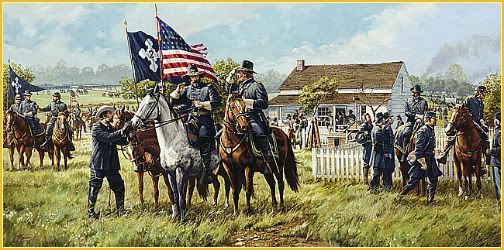
Expecting a Battle
Meade's Headquarters
Major General George G. Meade, commander of the Army of the Potomac, speaks to Major General Winfield S. Hancock of the Second Corps while fighting commences on the Union left.
By Dale Gallon
As the two great armies probed each other’s movements slowly northward, neither expected to fight one of the Civil War’s most momentous battles in the crossroads Pennsylvania town of Gettysburg. But during that summer, the citizens of Gettysburg had kept a wary eye on those movements, fearful that the ravages of war would disturb, and perhaps destroy, their tranquility.
The fateful day of July 1, 1863, dawned rainy and misty and by 7 am, it was cloudy and 72 degrees. As the sun rose, the fog and clouds cleared – the day was to become very hot and humid. By 8 am, the largest and most costly battle of the Civil War had erupted. The citizens would no longer need to worry about rumors.
Union General John Reynolds received orders from the recently appointed Union Commanding General George Meade at 4:00 am, instructing him to move the First and Eleventh Corps toward Gettysburg. At 5:00 am, Confederate General Henry Heth began to move his Confederate troops east towards Gettysburg. Heth's skirmishers came within sight of Union pickets at 7:30 am, July 1, 1863.
I got up early this morning to get my baking done before any fighting would begin. I had just put my bread in the pans when the cannons began to fire, and true enough the battle had begun in earnest, about two miles out on the Chambersburg Pike. What to do or where to go, I did not know. People were running here and there, screaming that the town would be shelled.
Confederate General A. P. Hill's brigades were clashing with General John Buford's Union cavalry, and Hill encountered stubborn resistance. While both sides sent couriers off for reinforcements, Buford held his ground – and the Battle of Gettysburg was under way.
Sallie wrote on July 1:
People are running here and there "screaming that the town would be shelled. No one knew where to go or what to do. My husband went to the garden and picked a mess of beans, for he declared the Rebels should not have one.
When she turned to her diary at nightfall, "the town was full of the filthy Rebels, " cock-a-hoop with success: "all is quiet, but 0! how I dread tomorrow."
On July 2, shells and bullets began to hiss and whine once more; but in his Gettysburg garden Sallie Broadhead's husband doggedly "picked a mess of beans... [and] persevered until he had picked all, for he declared the Rebels should not have one."
During the first three days of July, the town and its people shook with the fury of deadly fighting. Sallie spent most of the daylight hours with her family and immediate neighbors, huddled in the safety of the large basement of the David Troxell house next door. "The time we sat in the cellar seemed long, listening to the terrific sound of the strife; more terrible never greeted human ears."
On July 3, after Pickett's Charge had failed, the most optimistic Southerner knew that the Confederates had lost the day. When General Robert E. Lee told General George Picket to rally his division together Picket answered "General, I have no division." He never forgave Lee for what happened to his men at Gettysburg.
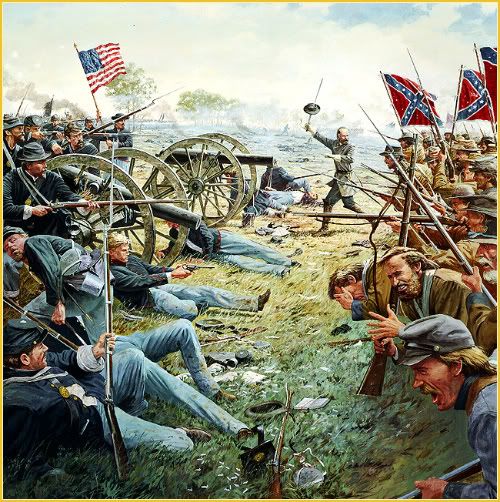
The Day Is Ours
Pickett's Charge July 3, 1863
Brigadier General Lewis Armistead leading the heroic and tragic moments at the High Water Mark
By Dale Gallon
General Lee, "the saddest man in the Army of Northern Virginia, " passed among his retreating, exhausted men, begging them to keep their ranks and assuring them: "It was my fault this time." Sir Arthur Fremantle found Confederate General James Longstreet sitting glumly on a fence and said tactlessly: "I wouldn't have missed this for anything." Replied the beaten general: "I would like to have missed it very much."
Sallie wrote in her diary on July 3, 1863:
We knew that with every explosion, and the scream of each shell, human beings were hurried, through excruciating pain into another world, and that many more were torn and mangled and lying in torment worse than death, and no one able to extend relief. The thought made me very sad, and feel that, if it was God's will, I would rather be taken away than remain to see the misery that would follow.
On July 4, General Lee packed up his troops and headed back to Virginia in a sudden downpour that washed the blood from the grass and pelted the wounded Confederate soldiers in the wagons heading home. The men who were too wounded to travel were brought to houses and laid side-by-side in the halls and rooms. Carpets, walls, and books that were used as pillows were stained with blood.
For the townspeople, the horror did not end with the Battle of Gettysburg, it continued on through summer and into fall with the stench of death and the agony of wounded Union and Confederate troops. The town of 2400 civilians had become one gigantic hospital, staffed by shopkeepers and lawyers, by housewives and teachers, and by children whose summer vacation became a learning experience in the realities of life. The needs of 22, 000 wounded men saw to that.
During the struggle, and its aftermath, Gettysburg's civilians faced almost incomprehensible situations. As the bodies of the dead quickly became infested, the battle wounds of the living also became flyblown. Maimed and wounded soldiers sometimes remained for days on the battlefield before receiving attention or being moved to a hospital. The exposed and open wounds also became prime breeding and feeding sites for carnivorous species of flies.
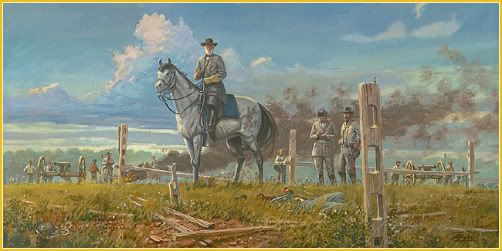
Ready to Fight Again
General Robert E. Lee among the guns of Colonel E. P. Alexander's artillery prepares for a Union counterattack shortly after the failure of Pickett's Charge.
By Dale Gallon
Sallie Broadhead recorded the following incident just a few days after the battle:
I assisted in feeding some of the severely wounded, when I perceived that they were suffering on account of not having their wounds dressed. I did not know whether I could render any assistance in that way, but I thought I would try. I procured a basin and water, and went to a room where there were seven or eight, some shot in the arms, others in the legs, and one in his back, and another in the shoulder.
I asked if anyone would like to have his wounds dressed? Someone replied, "There is a man on the floor who cannot help himself, you would better see to him." Stooping over him, I asked for his wound, and he pointed to his leg. Such a horrible sight I had never seen, and hope never to see again. His leg was all covered with worms [maggots].
By July 13, the small Broadhead home housed more than a family of three:
The town is as full as ever of strangers, and the old story of the inability of a village of 2500 inhabitants overrun and eaten out by two large armies to accommodate from 10 to 12, 000 visitors, is repeated almost hourly. Twenty are with us tonight, filling every bed and covering the floors.
Churches continued to be used as hospitals, causing parishioners to forgo normal services, prompting her to note in her diary, "We have had no Sundays... the churches have all been converted into hospitals." She also volunteered her services at the hospital in the Lutheran Seminary.
On July 14, Sallie made a diary entry that probably reflected the feelings of all the townspeople:
Little did I think... that I would have to record such terrible scenes as I have done. Had anyone suggested any such sights as within the bound of possibility, I would have thought it madness.
Gettysburg was the bloodiest battle in the war. About one third of those engaged were lost – the North had 23, 000 casualties, but the South lost 28, 000 soldiers. The Confederates couldn't afford such a loss.
Sallie Broadhead privately published her diary in 1864, as The Diary of a Lady of Gettysburg, Pennsylvania, from June 15 to July 15, 1863, in a 24-page pamphlet. It was intended solely "the kindred and nearest friends of the writer, " but it was printed as a fund-raiser for the Sanitary fairs in the Pennsylvania area.
ALL OF THE WONDERFUL ARTWORK OF THE BATTLE OF GETTYSBURG CAN BE PURCHASED AT Dale Gallon's Official Website
SOURCES
Gettysburg
They Saw It Happen
Gettysburg's Good News
Insects and the Civil War
War Comes to Gettysburg
The Women of Gettysburg – PDF FILE
Days Of Darkness: The Gettysburg Civilians
Historic People and Places of Gettysburg – PDF FILE
Gettysburg's Preview of War: Early's June 26, 1863 Raid
Source: feedproxy.google.com
Irene Rucker Sheridan
Wife of Union General Philip Sheridan
Irene Rucker, born in 1853 at Fort Union, New Mexico, and spent all her life connected to the military. She was the daughter of Brigadier General Daniel H. Rucker, who was Quartermaster General of the US Army. Her mother, Flora McDonald Coodey, was the daughter of Joseph Coodey, a half-blood Cherokee, and granddaughter of Jane Ross, a sister of the celebrated Cherokee Chief John Ross. Joseph Coodey was a well to do citizen who owned and operated a grist mill on Bayou Menard near the crossing of the old stage coach road between Fort Gibson and Tahlequah. Irene spent most of her girlhood in Washington, DC, and at various Army posts.
Philip Henry Sheridan was born in Albany, New York, on March 6, 1831, but grew up in Ohio. He attended West Point and, after a one-year suspension for assaulting a fellow cadet with a bayonet. He fell only seven demerits short of being expelled, and finished 34th out of 49. Several other members of his class of 1853 also became well-known, including John Schofield, John Bell Hood, and James McPherson – first in the class of 1853.
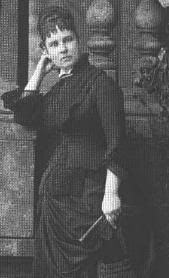
Irene Rucker Sheridan
An obscure lieutenant serving in Oregon when the American Civil War began, Sheridan rose to the command of the Union's cavalry by the time the Confederacy surrendered. He saw action in Mississippi, Tennessee, Kentucky, and in Virginia, where his campaign through the Shenandoah Valley laid waste to an important source of Confederate supplies.
Sheridan started the Civil War as Chief Quartermaster of the Army of Southwest Missouri. Feeling that he would be a better field commander than a support officer, Little Phil, 5' 5" tall, persisted until he got an appointment as a colonel with the Second Michigan Volunteer Cavalry. A month later he commanded his first forces in combat.
At the Battle of Booneville, July 1, 1862, he held back several regiments of General James R. Chalmers' Cavalry. His actions so impressed his superiors that they promoted him to Brigadier General and assigned him command of the 11th Division, Third Corps, Army of the Ohio.
In the spring of 1862, just after Booneville, one of his fellow officers gave him the horse that he would ride throughout the war. At the time, the regiment was stationed at Rienzi, Mississippi, and Sheridan named the horse Rienzi. Sheridan was always able to control him by a firm hand and a few words. He was as cool and quiet under fire as any veteran trooper in the Cavalry Corps. At the battle of Cedar Creek, October 19, 1864, the name of the horse was changed to Winchester, the name of the town made famous during Sheridan's ride through the Shenandoah Valley.
On October 8, 1862, Sheridan again distinguished himself during the Battle of Perryville. He pushed two Arkansas brigades across Bull Run but was ordered back by Third Corps commander, Major General Charles Gilbert. Both sides suffered heavy casualties.
On December 31, 1862, the first day of the Battle of Murfreesboro, Sheridan held back the Confederate advance until his ammunition ran out and he was forced to withdraw. For his actions, he was promoted to Major General, and put in charge of the Second Division, 4th Corps, Army of the Cumberland. In six months, he had risen from captain to major general.
At the Battle of Chickamauga, September 19 and 20, 1863, Sheridan along with the rest of the army was forced to withdraw after two days of heavy losses. At the Battle of Missionary Ridge on November 25, 1863, Sheridan took the initiative and broke through the Confederate lines. General Ulysses S. Grant, newly promoted to be general-in-chief of all the Union armies, decided he wanted Sheridan when he went east.
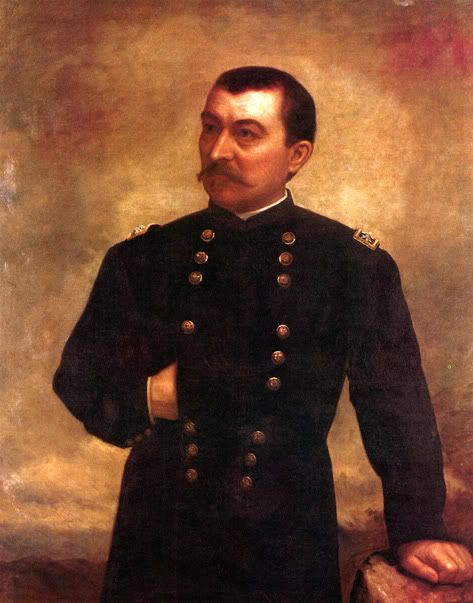
Philip Henry Sheridan
By William F. Cogswell
In March, 1864, Grant assigned him to command the Cavalry Corps of the Army of the Potomac. During the Overland Campaign, Sheridan fought at the Battle of the Wilderness (May 5-7, 1864), and Spotsylvania Court House (May 8-21, 1864). From May 9-24, 1864, Grant sent him on a raid toward Richmond. The raid was less successful than hoped, although his soldiers killed CSA General J.E.B. Stuart at Yellow Tavern (May 11, 1864). Rejoining the Army of the Potomac, Sheridan's cavalry excelled at Haw's Shop (May 28, 1864), seized Cold Harbor (June 1-12, 1864) and withstood a number of assaults until reinforced.
Army of the Shenandoah
All during the war, the Confederacy sent armies out of Virginia through the Shenandoah Valley to threaten Washington, DC, and a raid throughout Maryland and Pennsylvania. CSA General Jubal Early attacked Union forces near Washington and raided several towns in Pennsylvania. In August 1864, General Grant organized the Army of the Shenandoah. He put Sheridan in charge to drive Early out of the Shenandoah and close it as a route to Washington.
Sheridan went at it with vigor. He beat Early at Third Winchester and Fisher's Hill. In the final battle, at Cedar Creek, Sheridan rallied the troops who were retreating after a surprise attack – Early was defeated. Sheridan ordered total destruction in the Shenandoah Valley – his troops destroyed crops and livestock, seized stores and equipment, and burned what they couldn't remove. Sheridan said, "If a crow wants to fly down the Shenandoah, he must carry his provisions with him."
The destruction presaged the scorched earth tactics of US General William Tecumseh Sherman's March to the Sea through Georgia – deny an army a base from which to operate and bring the effects of war home to the population supporting it.
Sheridan again joined the Army of the Potomac at Petersburg in March, 1865. At Waynesboro on March 2, he trapped the remainder of Early's army and 1500 soldiers surrendered. On April 1, he cut off CSA General Robert E. Lee's lines of support at Five Forks, forcing Lee to evacuate Petersburg.
President Abraham Lincoln sent General Grant a telegram on April 7, 1865: "General Sheridan says, 'If the thing is pressed, I think that Lee will surrender.' Let the thing be pressed." Sheridan wrote in his memoirs, "Feeling that the war was nearing its end, I desired my cavalry to be in at the death."
Sheridan's finest service of the Civil War was demonstrated during his relentless pursuit of Robert E. Lee's Army of Northern Virginia, effectively managing the most crucial aspects of the Appomattox Campaign for General Grant. His aggressive and well-executed performance at the Battle of Sayler's Creek on April 6 effectively sealed the fate of Lee's army, capturing over 20% of his remaining men.
At Appomattox Court House, April 9, 1865, Sheridan blocked Lee's escape, forcing him to surrender later that day. After the surrender of Lee in Virginia and of General Joseph E. Johnston in North Carolina, the only significant Confederate field force remaining was in Texas, under General under Edmund Kirby Smith.
Sheridan was supposed to lead troops in the Grand Review of the Armies in Washington, DC, but Grant had appointed him commander of the Military District of the Southwest on May 17, 1865, six days before the parade. With orders to defeat Smith without delay and restore Texas and Louisiana to Union control, Sheridan headed south, but Smith surrendered before Sheridan reached New Orleans.
In March 1867, with Reconstruction barely started, Sheridan was appointed military governor of Texas and Louisiana. He severely limited voter registration for former Confederates, and then required that only registered voters (including black men) be eligible to serve on juries.
An inquiry into the deadly riot of 1866 implicated numerous local officials, and Sheridan dismissed the mayor of New Orleans, the Louisiana attorney general, and a district judge. He later removed Louisiana Governor James Wells, accusing him of being "a political trickster and a dishonest man." He also dismissed Texas Governor James Throckmorton, a former Confederate, for being an "impediment to the reconstruction of the State, " replacing him with the Republican who had lost to him in the previous election.
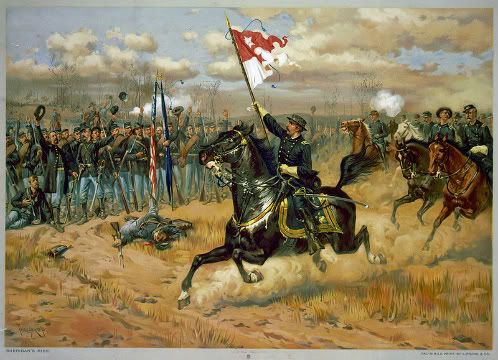
General Philip Henry Sheridan's Ride from Winchester
By Thure de Thulstrup
Sheridan had been feuding with President Andrew Johnson for months over interpretations of the Military Reconstruction Acts and voting rights issues, and within a month of the second firing, the president removed Sheridan, stating to an outraged General Grant that, "His rule has, in fact, been one of absolute tyranny, without references to the principles of our government or the nature of our free institutions."
Within six months, Sheridan succeeded William Tecumseh Sherman as commander of the Division of the Missouri, which encompassed the entire plains region from the Rocky Mountains to the Mississippi. There he immediately shaped a battle plan to crush Indian resistance on the southern plains. Following the tactics he had employed in Virginia, Sheridan sought to strike directly at the material basis of the Plains Indian nations.
Sheridan believed that attacking the Indians in their encampments during the winter would give him the element of surprise and take advantage of the scarce forage available for Indian mounts. He was unconcerned about the likelihood of high casualties among noncombatants, once remarking, "If a village is attacked and women and children killed, the responsibility is not with the soldiers but with the people whose crimes necessitated the attack."
The first demonstration of this strategy came in 1868, when three columns of troops under Sheridan converged on what is now northwestern Oklahoma to force the Kiowa, Comanche, Arapaho, and Cheyenne onto their reservations. The key engagement in this successful campaign was George Armstrong Custer's surprise attack on Black Kettle's village along the Washita, an attack that came at dawn after a forced march through a snowstorm.
Many historians now regard this victory as a massacre, since Black Kettle was a peaceful chief whose encampment was on reservation soil, but for Sheridan the attack served its purpose, helping to persuade other bands to give up their traditional way of life and move onto the reservations.
In March 1869, after Ulysses S. Grant became president and General Sherman became General of the Army, Sheridan was appointed lieutenant general with headquarters in Chicago. Returning to Chicago, he presided over the Great Chicago Fire of October 7-8, 1871. He brought troops into the city to stop looters and directed fire fighting and reconstruction. Although Sheridan's personal residence was spared, all of his professional and personal papers were destroyed.
While a bridesmaid at a wedding in Chicago, in 1874, Irene Rucker met General Sheridan, while his headquarters was there. Her father, General Daniel Rucker, Assistant Quartermaster United States Army, was on General Sheridan's staff. For the next few months, he courted her steadily, and contemporaries still recall the hero of the Civil War and "Miss Rucker riding down Wabash avenue in an open carriage."
On June 3, 1875, Irene Rucker married Philip Sheridan at the residence of her parents on Wabash Avenue in Chicago. She was a pretty brunette of 22; he was 44. The bride's dress was a white grosgrain silk softened by a tulle veil fastened with orange blossoms. The bride's accessories included a gold necklace with solitaire pendant, diamond solitaire earrings, and gold bracelets, all gifts of the bridegroom. General Sheridan and all the Army Officers appeared in full dress uniform.
After the wedding, the couple moved to Washington, DC, where they lived in a large house at Rhode Island Avenue and Seventeenth street N, bought for them by Chicago citizens who were grateful to General Sheridan for his work following the great Chicago fire in 1871. Irene quickly became one of the most popular members of Washington society, often entertaining as many as 300 callers a day. The Sheridans had four children: Mary, born in 1876; twin daughters, Irene and Louise, in 1877; and Philip, Jr., in 1880.
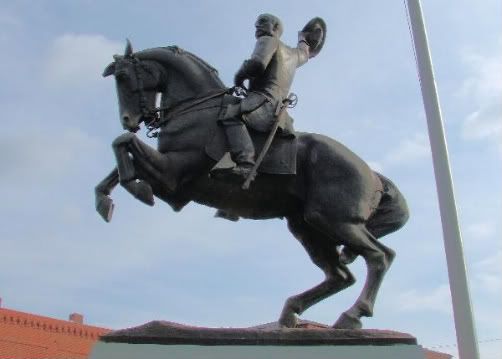
Sheridan Monument – Somerset, Ohio
In front of Perry County Courthouse
Sheridan refined his tactic of massive force directed in surprise attacks on Indian encampments, and mounted successful campaigns against the tribes of the southern plains in 1874-1875, and against those of the northern plains in 1876-1877, forcing them onto reservations with the tactics of total war. Although some of his generals in these campaigns, such as Nelson Miles, expressed a soldierly respect for the Indians they were fighting, Sheridan was notorious for his supposed declaration that "the only good Indian is a dead Indian, " which he steadfastly denied saying.
On November 1, 1883, Phil Sheridan succeeded William T. Sherman as Commanding General of the US Army, a position he held until shortly before his death. He was promoted to the rank of General of the Army of the United States by Act of Congress June 1, 1888, which is equivalent to a four-star general in the modern US Army. This is the nation's highest military office – which he achieved at the comparatively young age of fifty-two. He was the fourth man in US history to be so honored, the others being Washington, Grant, and Sherman.
In 1887, Sheridan had built a summer cottage in Nonquit, Massachusetts, overlooking Martha's Vineyard. The following year, he suffered a series of massive heart attacks, two months after sending his memoirs to the publisher. Although only 57 years old, hard living and hard campaigning and a lifelong love of good food and drink had taken their toll. Thin in his youth, he then weighed over 200 pounds.
General Philip Sheridan died August 5, 1888, at their vacation cottage, leaving Irene with four young children. His body was returned to Washington, DC, and lay in state at St. Matthew's Church until August 11, when he was laid to rest on a hillside facing the capital city near Arlington House, which helped elevate the Arlington National Cemetery to prominence.
General Philip Sheridan's Personal Memoirs (two volumes) were published soon after his death. Irene never remarried, saying, "would rather be the widow of Phil Sheridan than the wife of any man living." Curiously, Irene Rucker and his family are never mentioned in his memoirs.
Sheridan's famous horse Rienzi, renamed Winchester after it carried Sheridan on his desperate ride from there to Cedar Creek, was later stuffed and displayed at the Army museum on Governors Island in New York Harbor. In 1922, the museum was damaged by fire and it was decided that Winchester should be sent to the Smithsonian. The few remaining veterans of the city did not let Sheridan's war-horse leave without a fitting goodbye. They held a little goodbye ceremony, and the grandson of one of the veterans who attended read Thomas Buchanan Read's poem, Sheridan's Ride.

Fort Sheridan Centennial Legacy Statue
Depicts the General astride his mount Rienzi at the height of the Battle of Five Forks April, 1865.
A Time magazine article of May 1930 about Irene Sheridan stated:
Before the Senate last week came bill No. 319 to increase the pension of Irene Rucker Sheridan. Her present pension: $2, 500 per year. Proposed the bill: $5, 000. The Senate pensions committee recommendation: $3, 600. Up rose Colorado's Senator Phipps, a man of wealth and generosity, and said:
"The action of the committee reducing the amount is a mistake. Mrs. Sheridan is the widow of General Phil Sheridan who had a wonderful record. Mrs. Sheridan is well along in years and in all human probability, she will not enjoy the advantages of a pension for many years to come. I ask that the bill be approved in the original amount."
The Senate snubbed its pensions committee, and unanimously voted the widow of one of the nation's five generals $5, 000 per year. The bill must be acted upon by the House before she gets the money. Today Mrs. Sheridan, now living in retirement in Washington, is almost 80.
Since General Sheridan's death in 1888, Irene had divided her time between her home in Washington and the summer home in New England. She had not been active in Washington affairs since about the time of World War I. No one connected the wrinkled little old lady who gazed at Phil Sheridan's statue near her home with the great beauty of the 1870s.
Irene Rucker Sheridan died at her home at 2211 Massachusetts Avenue NW, Washington, DC, in 1936, at the age of 83. Funeral services were held in St. Matthew's Church, the same church in which Cardinal Gibbons performed the last rites for General Sheridan. Irene was survived by her three daughters, Mary, Irene, and Louise Sheridan, and two grandchildren, Carolina and Philip Sheridan III.
I don't usually make personal comments about the subjects of my posts, but this time I can't resist. While Sheridan was at times an able Civil War cavalry commander, he is one of my least favorite Civil War generals. First, because he had absolutely no regard for the lives of noncombatants. The second reason has to do with my Native American heritage. Regardless of his bigotry and carelessness, he seems to have had a wonderful wife.
SOURCES
Widow's Pension
Philip H. Sheridan
Scrappy Phil Sheridan
General Phil Sheridan
About Famous People
Irene Rucker Sheridan
General Daniel Henry Rucker
General Philip Henry Sheridan
Perry County Historical Society
Philip Henry Sheridan 1831 – 1888
Personal Memoirs of P. H. Sheridan
Source: feedproxy.google.com

Post a Comment